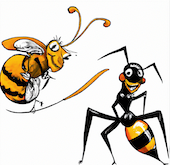In the German fairytale of the princess and the frog, a malicious witch had turned the prince into a frog. Only when a princess kisses the frog, will he become a human prince again. Is there such a kiss by the princess, to turn a human leech – a selfish person sucking the energy of others – into a bee – a creative highly collaborative person? The good news is that it seems there indeed is a way to turn a leech into a bee. Our approach is based on virtual mirroring . This means that in the privacy of their own phone or social network analysis, all members of an organization get an individual assessment of their “leechiness”. This is either shown in a social network based on communication structure, dynamics and content in email in the Griffin tool, or using our SocialCompass tool on the smartphone. The left picture shows the Griffin student network of a team of students participating in a seminar, the green nodes are “bees”, the red nodes are “ants”, and the few blue nodes are “leec



